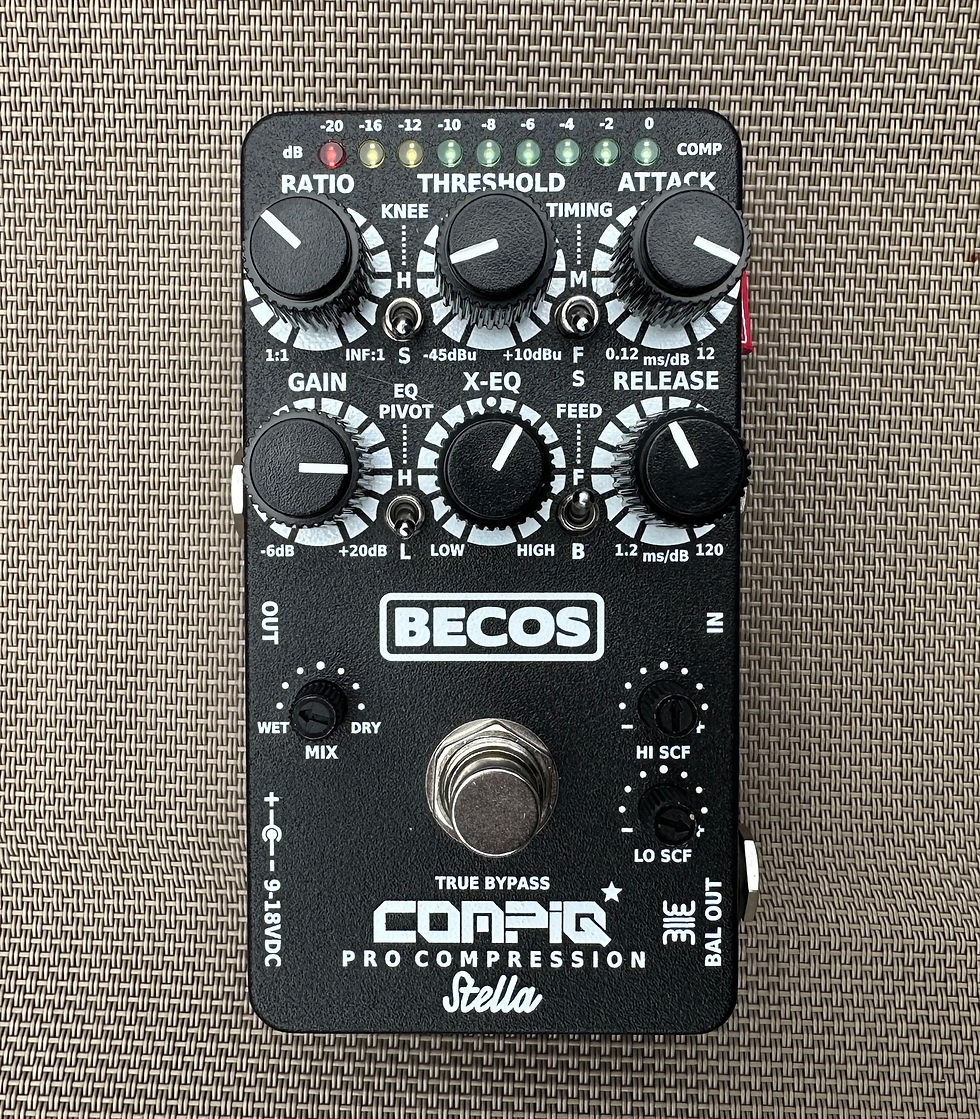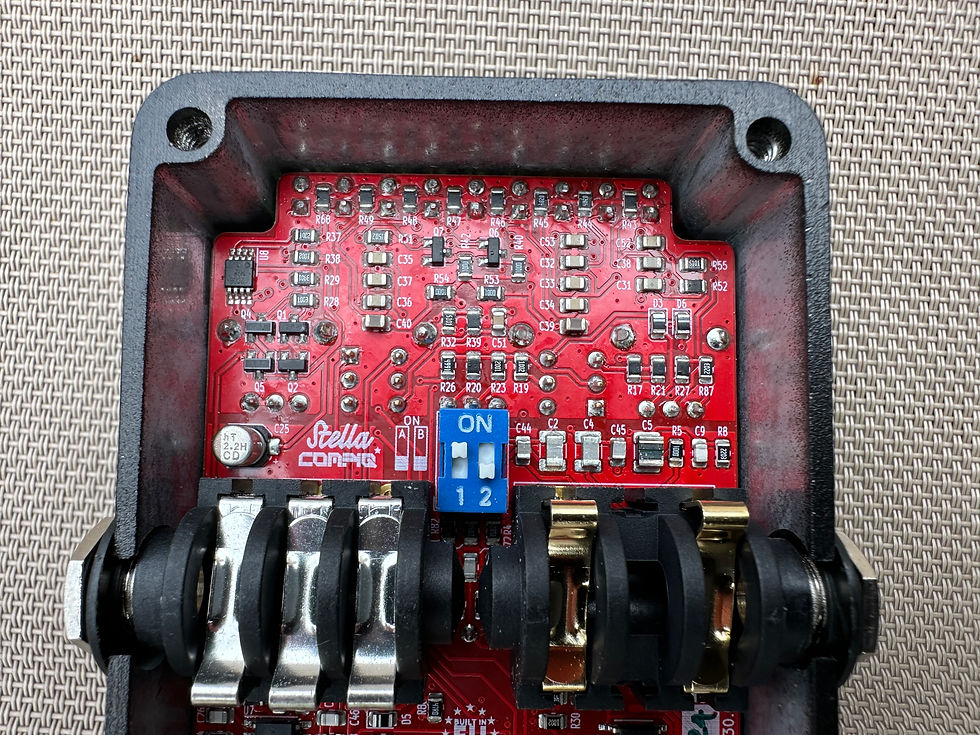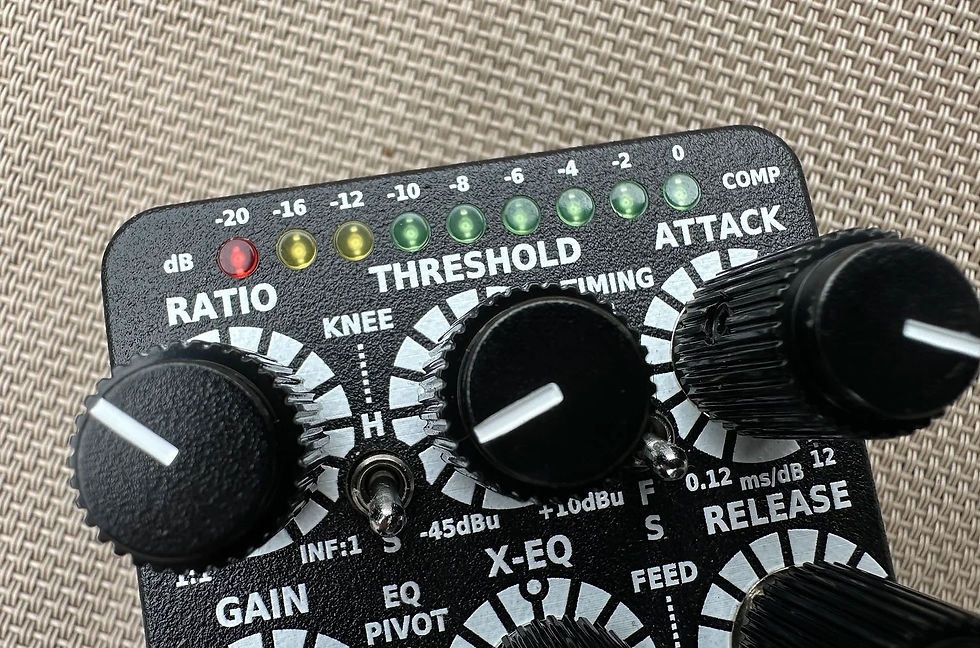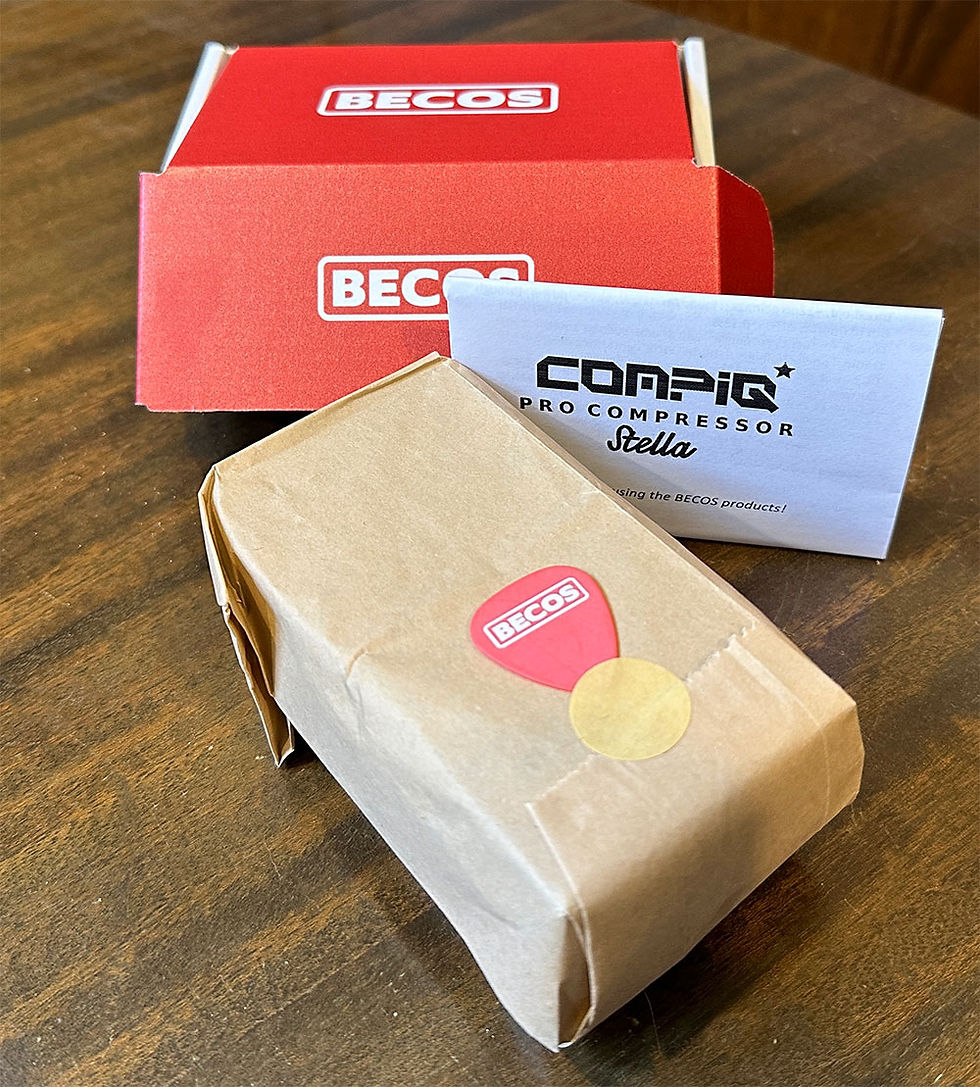This review of the latest version of the Becos Stella compressor is long overdue. If you haven't already, take a few minutes to read my review of the original Stella compressor by clicking here. I have reviewed many compressors since my review of the original Stella back in May of 2019 and I still think the lineup of compressors from Becos really stand out. Somehow the folks at Becos manage to cram in more functional versatility than pretty much anything else in its class on the market. Sure, you are buying a pedal format compressor, but you are getting a powerhouse circuit in such a small form factor. Now, the folks at Becos are back with a new version of Stella with notable modifications.

What's the same? The new Stella MK2 still features a THAT Analog Engine® and is a transparent sounding compressor. The face of the pedal still sports the same Ratio, Threshold, Attack, Release, Gain and EQ controls. I go into more detail about each of these controls in my review of the original Stella Compressor but here's the high-level summary.

The Ratio control offers a range of 1:1 (all the way counterclockwise) to infinite:1 (all the way clockwise). At approximately 9:00 you've dialed in a 2:1 ratio for some real nice mild, transparent useful (but very subtle) compression. Noon is approximately 4:1 and at 3:00 you've dialed in more like 10:1 which is getting pretty aggressive.
The Threshold control sets the signal level after which compression is applied. Essentially, compression is only going to be applied to a signal that crosses the threshold you've dialed in. Turning counterclockwise lowers the threshold. Set low (more counterclockwise) the compression will kick in sooner to even very quickly to even the smallest signal.
The Attack control sets the time needed to reach the highest level of compression (set by the ratio control). Further clockwise slows the attack, meaning letting more transient attack through. Turning counterclockwise speeds the attack, meaning clamping down sooner according to the ratio set.
The Release control sets the time needed for the compressed signal to return down to the input level and is set according to a scale of milliseconds per decibel of compression. Turning clockwise slows the release, meaning holding the compressed signal longer. Turning counterclockwise speeds the release, meaning releasing the compressed signal faster. I found a sweet spot for me at about noon.
The Gain sets the make-up gain because as you compress a signal you effectively drop the output signal.
The Tilt EQ gives you control of a gentle correction circuit where turning counterclockwise increases lower frequencies (+6db) while proportionately attenuating higher frequencies (-6db) around a set frequency point. Turning clockwise, the opposite occurs by elevating higher frequencies and attenuating lower frequencies. I appreciate that each dial is clearly marked with information in the full counterclockwise position and full clockwise position. Then there are the 4 mini switches on the face of the pedal. Three of these switches are consistent with functionality of the original version. The Soft/Hard Compression Knee switch allows you to select a harder more obvious compression or softer more subtle compression. When set to hard (flipped up), compression kicks in with a sharp corner making the compression more obvious. It's real nice and punchy. When set to soft (flipped down), the compression is applied more progressively with a soft corner curve. The EQ pivot switch chooses the EQ frequency point for the Tilt EQ function. In High (flipped up), the pivot frequency is set around 1KHz. For the guitarist, this is probably the best choice. For bassists, you'll want the switch set to Low (flipped down) where the pivot point is set around 330Hz. The Timing switch also has three positions — Manual, Auto Fast, and Auto Slow. In Manual (M) mode, you control the attack and release via the respective knobs as outlined earlier. In Auto Fast (F) and Auto Slow (S) positions, you activate an automatic dynamic timing circuit which automatically adjusts to your playing dynamics. According to the manual, auto fast typically uses 5-7ms for attach and 70ms for release. Auto slower is more like 10-15ms for attack and 100-220ms for release. Go with the auto fast or auto slow for the sake of simplicity if you want. By doing so you won't need to adjust attack and release. I am always skeptical of automatic settings in compressor pedals but frankly, I find myself using these automatic settings a lot here with Stella. Becos did a stellar job with the implementation. My preference is definitely automatic slow. The fourth switch on the original version of the Stella compressor was a side chain filter control which offered 3 positions — Normal (N), Low (L), and Deep (D). In Low position, more of the lower frequency (an additional -12db@90hz) is freed up to prevent triggering compression kicking in too early. In the Deep position, even more of the frequency spectrum is freed up (-12db@200hz). That was a really cool feature. Now though, with the new Stella MK2 you get more control of the side chain. More on that in a bit. On the MK2 the fourth switch was replaced with a side chain feed control allowing you to select either feed forward (FF) or feed-back (FB) compression types. In general, feed-back compression prioritizes "feel" over "precision". In other words, favoring a smoother or airy type of compression that some might describe as less "punchy". I like to think of it as more subtle or laid-back compression feel. Here, you get the option to experiment with both and notice the interactions with the Knee control and the side chain filters (which we'll talk about next). Having this type of feed forward or feed-back control really is like having two different compression designs in one little box.

Now, let's talk about the new side chain filter implementation. With the original Stella, you had the 3-way toggle to select three predetermined filter points. Now, with Stella MK2 you get an adjustable low-cut filter designed specifically for bass guitar. The low-cut filter is +/-12db @ 90hz, 12db/octave. Essentially, by rotating the dial more clockwise you are attenuating lows in the side chain making compression in the lower frequencies at the output reduced. In other words, you are telling the compression to not react as dramatically to low notes which makes for a more natural sound and feel because the lows feel more balanced or not as squashed. Then you have a complimentary adjustable high-cut filter in the sidechain to further balance things out. The high-cut filter is +/-7db @ 3khz, 12db/octave. This ensures that overly compressed high frequencies are preserved. So, what does this all mean? Basically, the goal of the design is to effectively compress lows, providing punch without unwanted pumping and preserving the overall desired audio spectrum balance. If you play a 5-string bass and want your B string to get aggressively squashed because it overly triggers the compression circuit, well then rotate the Lo SCF more clockwise. By doing so, you are telling the compression engine to react less to those frequencies. Both controls remain neutral when at noon. Rotating more clockwise increases the amount of cutting, while counterclockwise rotation boosts the same frequences in the side chain which results in the compressor being more sensitive to those frequencies. When playing a guitar with single coil pickups the side chain feature is also highly valuable to help bulk up very low amplitude signals at input, like thin-sounding single coil pickups.
The side chain filter is incredibly useful and once you get the hang of it, well, it will become part of your secret sauce.
The two side chain filter controls on Stella MK2 replaced a tape saturation circuit. Learn more about those controls by reading my review of the original Stella. Essentially, the intent of the circuit is to emulate vintage studio tape saturation prominent in the 60's. You get a form of distortion happening when high amplitude signals are recorded on magnetic tape. To my ear, it sounds really good. But, all things considered, the decision to replace this functionality with the dual side chain filter controls was a desirable trade off in my book. I believe more users of compression device will benefit from the side chain filter more than a circuit designed to more color your tone. That said, the saturation feature of the original Stella was definitely useful. I can see where some might seek out an original Stella specifically for the saturation engine. The last dial on the face of the pedal is the Dry/Wet mix — Just like what was found on the original Stella. This control allows you to blend the input clean signal with the output compressed signal which is called parallel compression. In the middle the mix is 50-50 and does wash out much of the compression feel. A little tweak goes a long way. The goal is to blend in more of your dry uncompressed signal when using higher compression levels to help restore transients. But wait! There Stella MK2 has one more trick up her sleeve. Remove the back plate of the pedal by removing the four screws. You will find a pair of dip switches inside that enable subtle adjustments to the internal dynamic frequency processing. The result is subtle coloration of the sound.

Setting one is called Spark and is set with the A switch in the up (on) position and the B switch in the down (off) position. The Spark position enhances highs adding a bit of sparkle up top. Setting two is called Tight and is set with the A switch in the down (off) position and the B switch in the up (on) position. The Tight position subtly dips low-mids, adding depth. Setting three is called Punch and is set with both switches A and B set to the up (on) position. The folks at Becos say the Punch setting creates a tube-like compression feel, "featuring velvety lows and warm highs". I'm not sure I would describe it quite like that as it doesn't remind me of a tube compressor all that much, but it does sound nice. I wouldn't really describe it as "punchy" either in the sense that, at least to my ear, it doesn't deliver a high impact, aggressive, cutting type tone. But it does add warmth and full coloration and sounds nice.
Of the three voicings I liked Spark best because it adds a bit of brilliance up top that can be quite pleasing indeed.
However, as nice as it is to have the option to switch between three different voicings, my preferred setting is with both switches in the neutral (off) position. The inherent changes are not radical enough to make me want to switch them up all that often. Additionally, I found I liked one setting more with one particular instrument and then other settings better with other instruments. Having to open up the case to access the switches and make switch position changes was an inconvenience and not something I found I really wanted to do all that often. I'd love to see a version with a toggle switch on the face of the pedal to make these voicing adjustments. That said, I'm not sure where the fine folks at Becos could find room in the circuit design to do such a thing. But here's to hoping. Becos now offers an optional transformer-coupled balanced output DI board in the Stella. It is called DITOS DI, and it provides a transformer-coupled balanced output in 1/4" TRS format that is suitable for direct recording or for sending the signal to a mixing console. I must say, wow! The transformer output is filled with natural warmth, with huge punchy lows and just all around brilliant tone. You definitely could just go instrument into Stella MK2 direct to console and find yourself really content with your tone.
And here's a little secret. Even on a pedalboard, try the DITOS output into your next pedal. I'm sure that's not the intent of the DITOS DI but you might be pleasantly surprised at the tonal goodness you hear.
I know I was. This is probably not ideal for all scenarios, but can it be very, very nice. The DITOS DI would allow you to use Stella as a desktop compressor in a studio environment. You could also use the DITOS DI output in the effects loop of a processor with superb results. Is the DITOS DI worth the extra cost? If you can stretch for it, I think you'd be glad you did. That said, without DITOS, Stella is still a superb piece of kit. I mean, this thing is really in a league of its own. Where else can you get this much control of functional parameters in such a small pedal board friendly form factor? Use it in the studio or on your pedal board. It really is quite amazing. Worth noting that without the DITOS board installed you can operate the Stella on a 9-volt battery. But the DITOS board takes up that space. The original Stella compressor had a 6-LED compression display. Now, in the new Stella MK2 there is an updated 9 multi-color LED reduction meter providing visual feedback on the compression level applied to the input signal. When activating the pedal, the 0db LED lights green indicating the pedal is powered up.

This meter provides visual cues as to how much compression is really taking place and is quite useful in helping dial in the compressor.
I said this about the original Becos Stella Compressor:
I'm not aware of any compressor on the market that packs this much punch in terms of functionality.
That is even more true now with Stella MK2. From the new 8-LED compression display to the robust High and Low side chain filter options compressor has so much to offer. When you consider the price point for all the functionality baked in it starts to feel like a real bargain.
It sounds great. Aside from the internal voicing switches and the tilt EQ control the inherent tonal output is quite transparent. What you get out of it is what you feed into it with quality compression applied. You might call it a surgically precise compressor. There is a pristine quality to the output. Of course, the voicing controls and EQ tilt control allows you to diverge from the transparent side of things but that's all optional. The tilt EQ can be really nice to help brighten up a dark sounding instrument. It's one of those nice to have features that you might not always use but its handy when needed. Just like the original Stella compressor, in terms of feel and tone I'd put the Becos CompIQ PRO Stella Compressor up against the likes of the Keeley Compressor Pro and Empress Bass Compressor or Empress MKII for sure.
Everything about the Becos Stella oozes quality and fidelity.
I suspect some might be turned off by the number of dials and switches and LED's. All of the functionality really does work well together. On the downside, there is a lot to wrap your arms around. And usability can be a bit tricky at times. For example, reaching those tiny switches mounted between dials isn't always quick and easy. I do still wish the mini dials mounted beside the foot switch could be larger though I'm not sure how it would be possible without making the pedal considerably larger. The little dials don't have the greatest feel either — sort of cheap feeling plastic. The larger knobs are plastic but rotate with a solid feel. But you can also use this pedal simply if you wish. Set the pedal to auto fast or slow and then focus in on the core Ratio, Threshold and Gain controls. Leave everything else alone. At least at first. Then start testing out the other functions. If you are reading this thinking Stella just seems too complex, have a look at other more simple offerings from Becos such as the CompIQ MINI ONE Pro Compressor and CompIQ MINI Pro Compressor. Both of those compressors are simpler and stellar in their own right. The enclosure is a Hammond brand 1590B and looks and feels nice. Input and output jacks are side mounted, as is the power input. I prefer top mounted jacks, but it is a tradeoff to accommodate all of in intricacies and complexities of the circuit board. Becos did a nice job with the packaging.

The Stella MK2 is a Blackmer® VCA type compression engine based on a THAT 4320 Analog Engine®. It is hand-assembled in Vienna, Austria and comes with a 3-year warranty (direct to manufacturer, international, transferable). There is a lot to like here about the newly improved Becos CompIQ STELLA Pro compressor pedal for bass & guitar. The words Pro Compression are showcased on the front of the pedal and that really is a true statement.
The Becos Stella MK2 compressor is a remarkably powerful compressor/limiter pedal. All of its functionality works well together and sounds fantastic.
It is probably the only compressor you would ever need. From my perspective, for many use cases the Becos Stella MK2 is one of the best compressor pedals currently on the market. Pros: • Versatility • Quality • Excellent tonal qualities • Form factor • LED meter • Optional DITOS transformer output • Price when you consider the extreme amount of functionality offered Cons: • Possibly too complex for some • With the robust feature set comes usability tradeoffs • Switches are small and crammed between knobs, not good for big fingers • Voicing switches located internally are not easily accessible
USA Retail Price: $329 ($429 with DITOS Transformer DI)
In the USA, you can order from GearHero.com
BecosFX.com
View all compressor pedal reviews

Comments